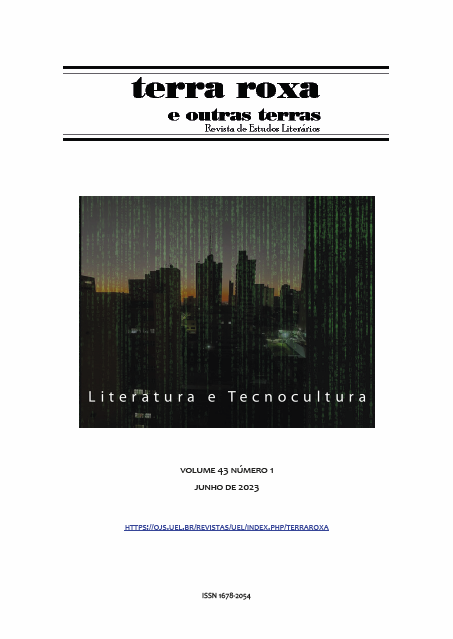Mudanças tecnoculturais no ato da leitura: tema e horizonte em Kentucky Route Zero
DOI:
https://doi.org/10.5433/1678-2054.2023vol43n1p55Palabras clave:
Teoria do efeito estético, Game studies, Videogames, Kentucky Route ZeroResumen
O artigo investiga a construção de efeitos estéticos entre videogames e seus jogadores, tomando por base a tradição acadêmica da teoria literária e trazendo como exemplo de análise o jogo Kentucky Route Zero (Cardboard Computer 2020). Partimos de uma abordagem interdisciplinar que incorpora a teoria do efeito de Wolfgang Iser (1996, 1999) à área de game studies, buscando responder à seguinte pergunta: para o jogador, como se dá o processo de construção de sentidos em uma mídia em que é convidado a interferir diretamente na materialização textual da obra através de sua agência? Nossos esforços investigativos nos levam a propor, baseando-nos em Murray (2003) e Juul (2019), uma adaptação da teoria do efeito de Iser para a arte dos videogames, a pertinência da qual é subsequentemente testada através da análise de um jogo específico. Os resultados da pesquisa parecem indicar uma nova configuração tecnocultural dos atos de recepção e interpretação, na qual 1) o jogador concretiza a materialidade textual através de suas escolhas e 2) as escolhas não tomadas pelo jogador ainda são incorporadas à estrutura de tema e horizonte da obra, e podem contribuir para a construção de sentidos tanto quanto as decisões efetivamente tomadas.
Descargas
Citas
AARSETH, Espen. Cybertext: perspectives on ergodic literature. Baltimore: The Johns Hopkins University, 1997. DOI: https://doi.org/10.56021/9780801855788
BARTHES, Roland. S/Z. Lisboa: Edições 70, 1999.
CARDBOARD COMPUTER. Kentucky Route Zero: TV Edition. [S. l.]: Annapurna Interactive, 2020a. videogame.
CARDBOARD COMPUTER. Kentucky Route Zero. [S. l.]: Cardboard Computer, 2020b. Disponível em: http://kentuckyroutezero.com/.
ESKELINEN, Markku. The gaming situation. Game Studies, v. 1, n. 1, 2001. Disponível em: http://www.gamestudies.org/0101/eskelinen/.
FASSONE, Riccardo. Every game is an island: endings and extremities in video games. New York: Bloomsbury, 2018.
FRASCA, Gonzalo. Videogames of the oppressed: videogames as a means for critical thinking and debate. Dissertação (Mestrado em Information Design and Technology) - School of Literature, Communication and Culture, Georgia Institute of Technology. Athens, 2001.
ISER, Wolfgang. O ato da leitura: uma teoria do efeito estético. v. 1. Trad. Johannes Kretschmer. São Paulo: 34, 1996.
ISER, Wolfgang. O ato da leitura: uma teoria do efeito estético. v. 2. Trad, Johannes Kretschmer. São Paulo: 34, 1999.
JUUL, Jesper. Half-real: videogames entre regras reais e mundos ficcionais. Trad. Alan Richard da Luz. São Paulo: Blucher, 2019.
LANDOW, George P. Hypertext: the convergence of contemporary critical theory and technology. Baltimore: The Johns Hopkins University, 1992.
MURRAY, Janet. Hamlet no holodeck: o futuro da narrativa no ciberespaço. Trad. Elissa Khoury Daher e Marcelo Fernandez Cuzziol. São Paulo: Itaú Cultural, 2003.
SALEN, Katie & Eric Zimmerman. Rules of play: game design fundamentals. Cambridge: MIT Press, 2004.
Descargas
Publicado
Cómo citar
Número
Sección
Licencia
Derechos de autor 2023 Natalia Corbello, Liliam Cristina Marins

Esta obra está bajo una licencia internacional Creative Commons Atribución 4.0.
Los autores que publican en esta revista aceptan los siguientes términos:
a) Los autores conservan los derechos de autor y otorgan a la revista el derecho de primera publicación, siendo la obra licenciada simultáneamente bajo la Licencia Creative Commons Reconocimiento-No Comercial 4.0 Internacional, permitiendo la compartición de la obra con reconocimiento de la autoría de la obra y publicación inicial en este periódico académico.
b) Los autores están autorizados a asumir contratos adicionales por separado, para distribución no exclusiva de la versión del trabajo publicado en esta revista (por ejemplo, publicar en un repositorio institucional o como capítulo de libro), con reconocimiento de autoría y publicación inicial en esta revista. diario.
c) Se permite y anima a los autores a publicar y distribuir su trabajo en línea (por ejemplo, en repositorios institucionales o en su página personal) después del proceso editorial, ya que esto puede generar cambios productivos, así como aumentar el impacto y la citación del trabajo publicado (Ver Efecto del Acceso Abierto).
d) Los autores de los trabajos aprobados autorizan a la revista para que, luego de la publicación, transfiera su contenido para su reproducción en indexadores de contenido, bibliotecas virtuales y similares.
e) Los autores asumen que los textos sometidos a publicación son de su creación original, asumiendo total responsabilidad por su contenido en caso de objeción por parte de terceros.




















